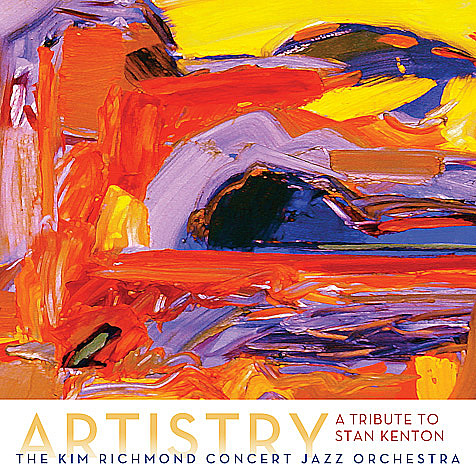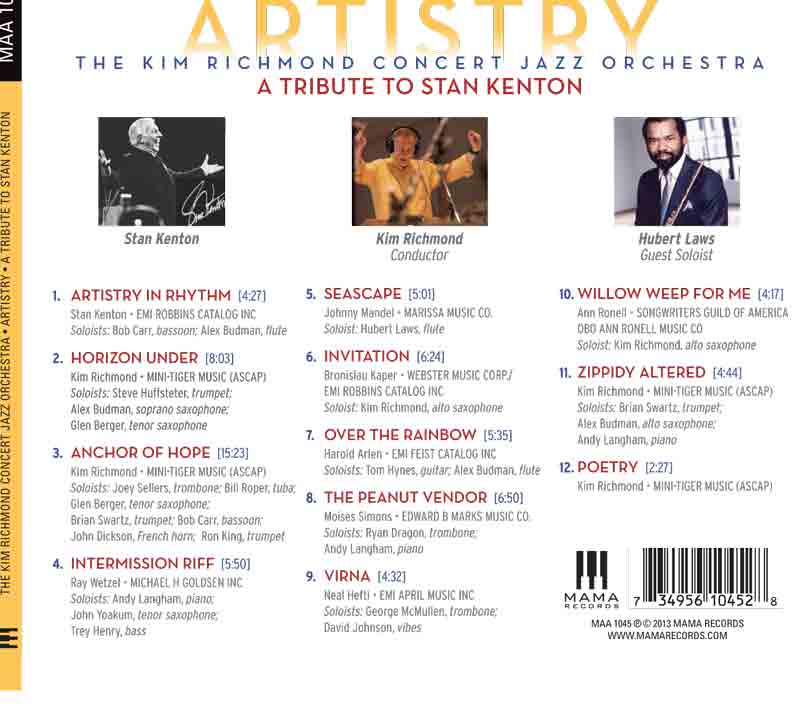 |
Credits
Produced by Kim Richmond
Executive Producer: Luci Janssen.
Shari Lyon, Assistant to Executive Producer
Recorded October 31, and November 1, 2012 at Capitol Studio A, Hollywood, CA
Recording engineer, mixing, mastering: Rich Breen
Assistant engineer (for Capitol): Charlie Pakarri
Booth consultant: Don McDougal and Phil Norman
Orchestra contractor: Bob O’Donnell
Liner notes: Kim Richmond
Cover art: 10” x 12” oil on canvas by Chris Zambon
Photography: Marvin Ross Photography, Boulder, Colorado; Luci Janssen
Layout/design: Darby Christensen, Summit Records
Poetry: Luci Janssen
THIS RECORDING WAS NOMINATED FOR A GRAMMY AWARD
|
Personnel:
|
Selections:
|
Kim Richmond: conductor, arranger, alto saxophone solo
Hubert Laws: special guest jazz flutist
Woodwinds: Alex Budman (alto saxophone, soprano saxophone, flute, piccolo)
Bob Crosby (alto saxophone, oboe, flute)
Glen Berger (tenor saxophone, clarinet, flute)
John Yoakum (tenor saxophone, English horn, flute)
Bob Carr (baritone saxophone, bassoon, bass clarinet
Trumpets: Bob O'Donnell, Ron King or Jamey Hovorka, Steve Huffsteter, Brian Swartz
French horns: John Dickson, Stephanie O'Keefe
Trombones: Ryan Dragon, Joey Sellers, George McMullen, Craig Gosnell
Tuba: Bill Roper
Rhythm: Tom Hynes (guitar), Andy Langham (piano), Trey Henry (bass), Ralph Razze (drums), Dave Johnson (mallet percussion), Scott Breadman (hand percussion) |
|
Tribute
This recording is a tribute to a legendary figure in jazz, Stan Kenton. He maintained his orchestra by inventing new directions in music from 1941 to 1979 and he was synonymous with contemporary innovation, being an avid promotor of this new and different music. While Kenton kept an active road band, he also founded the Los Angeles Neophonic Orchestra in 1964. Led by Stan, the Neophonic Orchestra consisted of the top jazz and studio players and its mission was to perform new and innovative works.
The Kim Richmond Concert Jazz Orchestra shares this mission.
Kenton was not only a monumental icon in jazz and modern music, but also in jazz education. He spearheaded the formation of the National Band Camps, teaching jazz to youngsters. He was instrumental in forming the National Association of Jazz Educators (later expanded to be the International Association of Jazz Educators) which flourished into the next century. This tribute continues his message by presenting works that we think he would have encouraged, enjoyed and endorsed.
Besides new originals and a few new treatments of standards, there are three pieces that are adventurous new treatments of Kenton titles.
This CD by the Kim Richmond Concert Jazz Orchestra was recorded at Capitol Records Studio A (the same studio in which Kenton recorded) on October 31 and November 1, 2012. It is interesting to note that this latter date marks the sixty-second anniversary of Stan Kenton’s first recording session for Capitol Records in 1940. |

|
Liner Notes
|
-
Artistry in Rhythm
Stan Kenton’s theme song is perceived differently here, but contains all of the elements that are identified with this lasting composition through the years. Bob Carr’s extraordinary bassoon solo excursion into the extreme high and low ranges of the instrument leads to an uptempo swing with Latin overtones, the trombones being featured on the repeated technical figure found in many versions of this piece. This culminates in a short cymbal cadenza exchange by Ralph Razze, Dave Johnson and Scott Breadman, out of which Alex Budman’s flute renders the concluding statement of the theme, followed by the monumental brass ending.
- Horizon Under
This work is mood-setting with a hip military vibe from drums against proclamatory “jabbering” trumpets. The sinuous theme enters with low instruments and John Proulx’s voice, and winds its way to the lovely colors of Steve Huffsteter’s solo trumpet. Brilliant exchanges and interactions from Alex Budman on soprano saxophone and Glen Berger on tenor, are followed by a moment of contrasting moods. We go out big and with a bang. My inspiration here was some of the writing of Vince Mendoza. The title is an homage to a friend and colleague whose life path long overlapped with mine, and who flourished in Sydney, Australia.
- Anchor of Hope
The album’s centerpiece, this composition has a extensive introduction featuring varied orchestral brass and woodwind colors. The theme is extremely dynamic and the groove progresses to Latin, guided by Scott Breadman’s congas and Trey Henry’s bass. The solo section starts with the ingenuous Joey Sellers on trombone (finally joined, on the ending cadenza, by Bill Roper’s quirky tuba) Glen Berger on tenor and Brian Swartz on trumpet trade and develop ideas together. With a complete change of mood, and following bassoon solo passage by Bob Carr, we progress to John Dickson’s statements on solo French horn, proving the horn can be a low instrument as well as a high one. With a return to the main theme, the majestic and monumental ending features Ron King on solo high trumpet against a massive ensemble.
- Intermission Riff
One of the most well-known of Stan Kenton’s theme, this piece is the traditional arrangement (with solos by John Yoakum on tenor and Trey Henry on bass), in the middle of which is inserted an ensemble rendering of the famous Carl Fontana trombone solo from a middle 50s recording (Kenton in Hi-Fi).
- Seascape
Special guest soloist flutist Hubert Laws joins us to brilliantly perform one of Johnny Mandel’s lesser-known themes. Hubert has long been my favorite jazz flute player and I was thrilled to have him with us, especially to give his interpretation to this beautiful melody.
- Invitation
One of my favorite melodies, this Bronislau Kaper composition was arranged as a Kenton-style solo feature for my alto saxophone. Starting with slow dark and moody undertones, the first part of the them is rubato. The bridge goes to medium uptempo. After the improvised solo section, the ensemble states weaving lines straying away from the tune’s traditional form. This progresses to a parting of the drums (continuing it’s own swing rhythm) against the ensemble (in conducted rubato). The solo alto brings it all back together again and the ending has a solo flourish.
- Over the Rainbow
Perhaps Harold Arlen’s most famous composition, “Over the Rainbow” has been on my list of arrangements to write for many years. What made me pause is the fact that there are so many great arrangements of this tune. Hopefully you will find something fresh in this approach. Tom Hynes is featured on guitar and Alex Budman has an outing on flute before the piece builds towards a somewhat surprising ending. Thanks mainly to Michel LeGrand for the inspiration.
- The Peanut Vendor
Another of the Stan Kenton warhorses, this arrangement is an effort to bring a more modern perspective to the tune, without losing its essential and identifying elements, some of which were great vehicles from Kenton’s imagination. The featured soloists here are Ryan Dragon on trombone and Andy Langham on piano. They are left to their own devices without hindrance from those pesky chord changes.
- Virna
This has been a favorite theme of mine for many years, written for a movie by Neal Hefti. It describes the glorified entrance of the beautiful actress Virna Lisi in many of the scenes. This arrangement is done mostly rubato. The middle section is a light 3/4 that features soloists George McMullen on trombone and David Johnson on vibraphone.
- Willow Weep for Me
A standard by one of the best female composers, Ann Ronell, this features my alto saxophone on melody and improv. This provides a chance to explore subtlety different time feels, and to develop a very personal interpretation.
- Zippidy Altered
As the name might imply, this was originally based on a well-known melody from a movie. However, not only is the title altered, but the melody and harmonies are as well. Only the contour remains. Soloists are Brian Swartz (trumpet) and Alex Budman (alto), together and individually, and (briefly) Andy Langham (piano).
- Poetry
This short orchestral tone poem features textures and colors not usually heard in a jazz context. The woodwinds (especially the double reeds) and the French horn are brought to bear and utilized to invoke a modern sound. The voice of John Proulx helps meld the entire ensemble in chosen places. This acts as the Coda for the project, presenting the orchestral sound of the Concert Jazz Orchestra.
|


